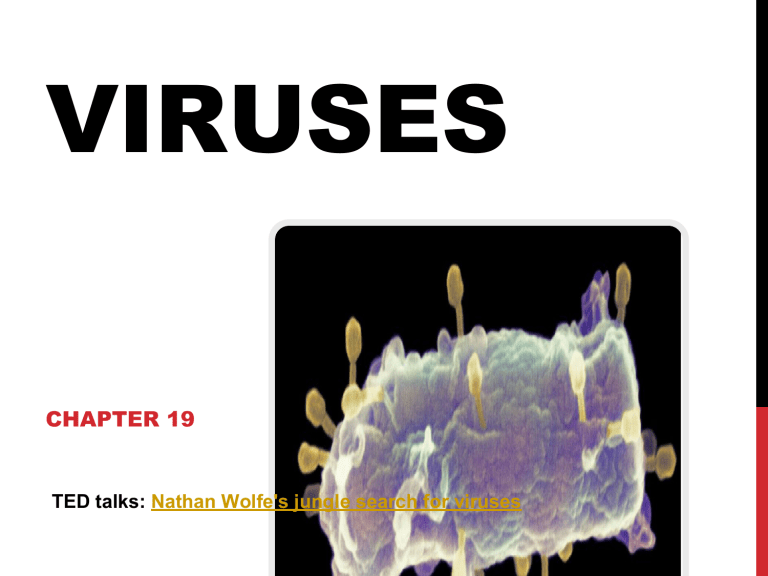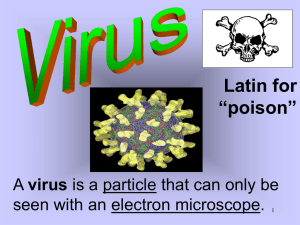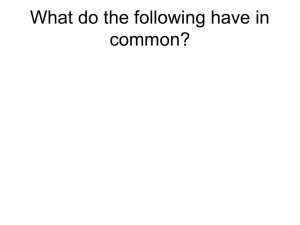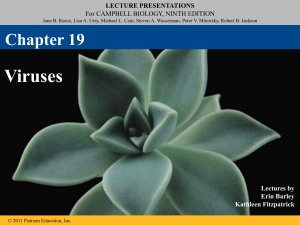
VIRUSES CHAPTER 19 TED talks: Nathan Wolfe's jungle search for viruses BIG IDEA 3: LIVING SYSTEMS STORE, RETRIEVE, TRANSMIT, AND RESPOND TO INFORMATION ESSENTIAL TO LIFE PROCESSES EU 3.A: Heritable information provides for continuity of life. •EK 3.A.1: DNA, and in some cases RNA, is the primary source of heritable information. EU 3.C: The processing of genetic information is imperfect and is source of genetic variation •EK 3.C.3: Viral replication results in genetic variation and viral infection can introduce genetic variation into the hosts. WHAT YOU MUST KNOW: • The components of a virus. • The differences between lytic and lysogenic cycles. BACTERIA VS. VIRUSES BACTERIA • Prokaryotic cell • Most are free-living (some parasitic) • Relatively large size • Antibiotics used to kill bacteria VIRUS • Not a living cell (genes packaged in protein shell) • Obligate Intracellular parasite • 1/1000 size of bacteria • Vaccines used to prevent viral infection • Antiviral treatment VIRUSES Video: Understanding viruses Very small (<ribosomes) Components = nucleic acid + capsid •Nucleic acid: DNA or RNA (double or single-stranded) •Capsid: protein shell •Some viruses also have viral envelopes that surround capsid and helps them infect hosts Limited host range (eg. human cold virus infects upper respiratory tract) Reproduce within host cells SIMPLIFIED VIRAL REPLICATIVE CYCLE BACTERIOPHAGE • Infects bacterial cells • Complex capsids that encloses their DNA • A protein tailpiece that attaches the phage to the host • They inject phage DNA inside host cell • Bacteria have defenses against phages • use restriction enzymes that recognize and cut up certain phage DNA LYTIC CYCLE OF T4 PHAGE BACTERIOPHAGE REPRODUCTION ●Lytic Cycle: ◦Use host machinery to make copies of virus ◦Death of host cell by rupturing it (lysis) ◦Virulent phages replicate by this method ●Lysogenic Cycle: ◦Phage DNA incorporated into host DNA and replicated along with it… without destroying host ◦Integrated viral “phage” DNA = prophage ◦Host cell division copies viral DNA Temperate Phage: uses both methods of replication LYTIC CYCLE VS. LYSOGENIC CYCLE Viral Life Cycles (video) ANIMAL VIRUSES HAVE A MEMBRANOUS ENVELOPE Host membrane forms around exiting virus Difficult for host immune system to detect virus RETROVIRUS • RNA virus that uses reverse transcriptase (RNA → DNA) • Newly made viral DNA inserted into chromosome of host • Host transcribes viral DNA (= provirus) into RNA • RNA uses to make new virus parts • Example: HIV • The broadest variety of RNA genomes is found in viruses that infect animals HIV = Retrovirus HIV • Infects white blood cells • HIV+: provirus (DNA inserted) • AIDS: active viral reproduction VACCINES Weakened virus or part of pathogen that triggers immune system response EMERGING VIRUSES = MUTATION VIDEO: OF EXISTING VIRUSES How Flu Viruses Attack VIROIDS • Small, circular RNA molecules that infect plants • Cause errors in regulatory systems that control plant growth • Eg. coconut palms in Philippines PRIONS • Misfolded, infectious proteins that cause misfolding of normal proteins • Eg. mad cow disease (BSE),CreutzfeldtJakob disease (humans), scrapie (sheep) DISEASES CAUSED BY PRIONS • Prions act slowly – incubation period of at least 10 years before symptoms develop • Prions are virtually indestructible (cannot be denatured by heating) • No known cure for prion diseases





